Los Angeles officially the City of Los Angeles and often known by its initials L.A., is the second-largest city in the United States after New York City, the most populous city in the state of California, and the county seat of Los Angeles County. Situated in Southern California, Los Angeles is known for its Mediterranean climate, ethnic diversity, sprawling metropolis, and as a major center of the American entertainment industry. Los Angeles lies in a large coastal basin surrounded on three sides by mountains reaching up to and over 10,000 feet (3,000 m)
Los Angeles – Rare & Old Photos| Mega Series Part 1
1. Sunset Blvd. and Doheny Drive in West Hollywood c.1937
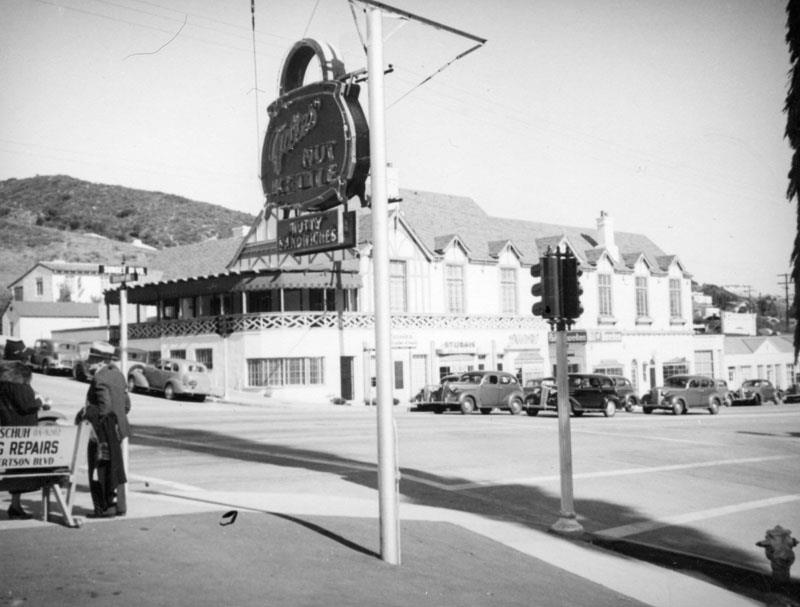
Sunset Boulevard and Doheny Drive in West Hollywood in 1937 would have looked quite different from what it does today. Here are some details about the area during that time:
The Sunset Strip: The section of Sunset Boulevard that runs through West Hollywood was known as the Sunset Strip, and it was already a popular destination for nightlife and entertainment in the 1930s. Many nightclubs, restaurants, and theaters lined the street, making it a hub of activity.
The Garden of Allah: One of the most famous hotels on the Sunset Strip at the time was the Garden of Allah. The hotel was known for its luxurious bungalows and its celebrity clientele, which included Greta Garbo, Errol Flynn, and F. Scott Fitzgerald.
Doheny Drive: Doheny Drive was a residential street that intersected with Sunset Boulevard. It was named after Edward Doheny, a prominent oil tycoon who owned much of the land in the area.
The Beverly Hills Speedway: Just a few miles north of Sunset Boulevard, the Beverly Hills Speedway was a popular destination for auto racing enthusiasts. The track hosted many famous drivers and races during the 1920s and 1930s, but it closed in 1924 due to safety concerns.
Architecture: The architecture of the buildings along Sunset Boulevard and Doheny Drive would have reflected the styles of the time, which included Art Deco and Spanish Colonial Revival. Many of the buildings would have featured ornate details and decorative elements.
Sunset Boulevard and Doheny Drive in West Hollywood in 1937 would have been a vibrant and exciting area, with a mix of nightlife, residential areas, and cultural landmarks.
2. A jaguar is used as a live model in a children’s sculpting class c.1923
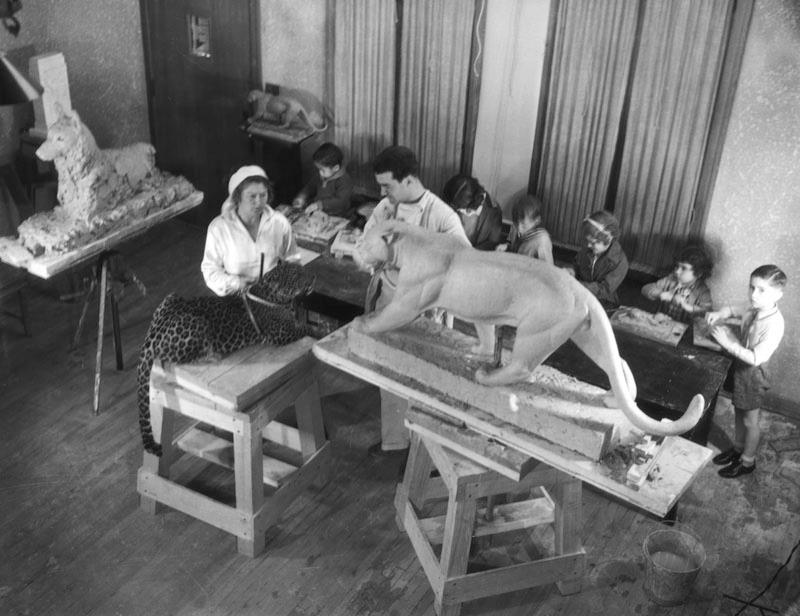
The photograph of a jaguar being used as a live model in a children’s sculpting class taken in 1923 offers a unique glimpse into the art education of the time. At the time, it was common for art classes to use live models for their students, but the use of a wild animal was highly unusual and adds an interesting twist to the story.
In the photograph, we can see a group of children gathered around the jaguar, who is positioned on a raised platform in the center of the room. The children are each working on their own sculptures, using clay and other materials to create three-dimensional representations of the animal.
While the use of live animals in art education is no longer considered ethical or appropriate, the photograph offers an interesting historical perspective on the ways in which art education has evolved over time. Today, many art classes use a variety of techniques and materials to help students develop their skills and express their creativity, but the use of live models is now limited to human subjects or non-living objects.
3. Lady Godiva and Lady Melody, a strip tease dancer and her horse c.1951
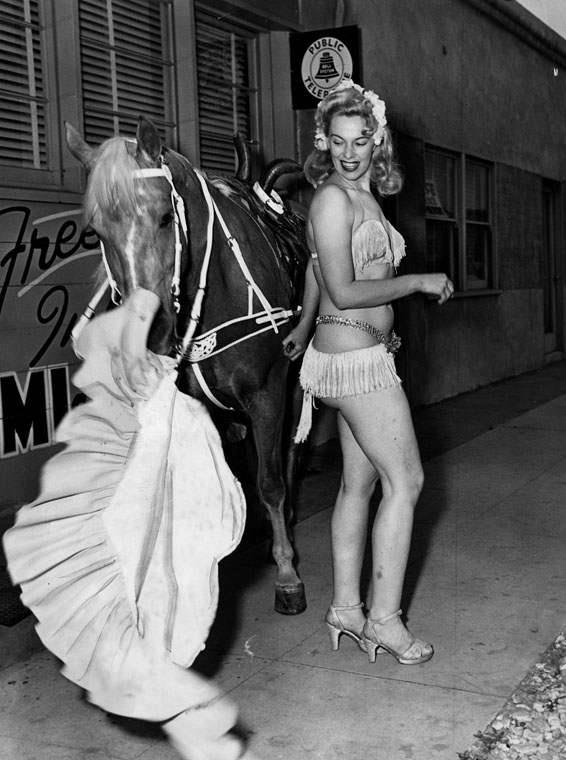
The photograph of Lady Godiva and Lady Melody taken in 1951 depicts a strip tease dancer and her horse performing in Los Angeles. Lady Melody was a popular performer in the burlesque scene during the 1950s, known for her unique act in which she would strip down to a leotard and perform acrobatic tricks on the back of her horse.
In the photograph, we can see Lady Melody riding Lady Godiva, her beautiful white horse, down the street while wearing a revealing costume and a feathered headdress. The image captures the playful and flirtatious spirit of the burlesque scene during this time, which was often seen as a form of escapism and entertainment during a period of social and political change in the United States.
While strip tease and burlesque performances were often controversial and criticized for their sexual content, they also played an important role in the development of modern entertainment, influencing the evolution of music, dance, and fashion in the decades that followed.
The legacy of burlesque lives on in the form of modern-day cabaret and burlesque performances, which continue to captivate audiences with their playful and provocative style. While much has changed since the 1950s, the spirit of Lady Melody and Lady Godiva lives on in the world of modern entertainment.
4. Looking west on Hollywood Blvd. from Hudson c.1930
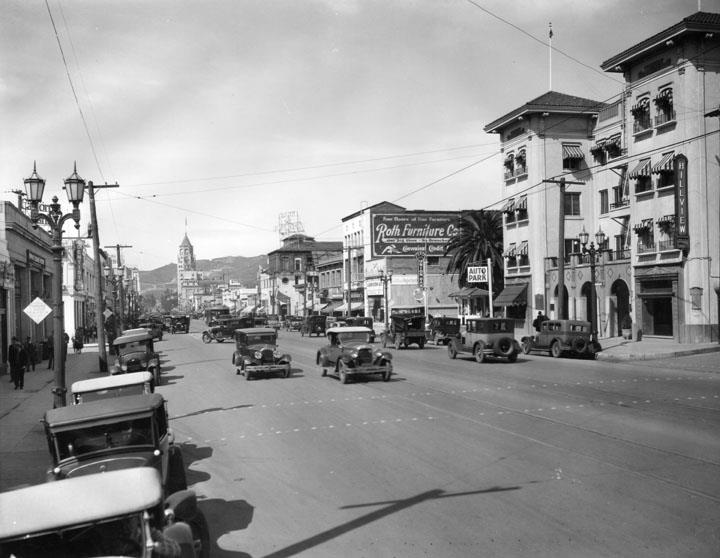
The photograph of Hollywood Boulevard taken in 1930 captures the bustling energy and excitement of the famous street during this time. In the image, we can see a row of businesses and storefronts lining the street, including a movie theater, a hotel, and a variety of shops and restaurants.
At the time, Hollywood Boulevard was the epicenter of the movie industry, with many of the major studios and production companies located in the area. The street was also home to a variety of entertainment venues, including nightclubs and theaters, which drew large crowds of locals and tourists alike.
The image shows a number of people walking along the sidewalk, including pedestrians, shoppers, and workers. The cars and buses parked along the street are a reminder of the role that automobiles played in shaping the development of the city during this time.
Today, Hollywood Boulevard is still a major attraction in Los Angeles, drawing visitors from around the world to its many historic landmarks, including the TCL Chinese Theatre, the Hollywood Walk of Fame, and the Dolby Theatre, home to the Academy Awards. While much has changed since the 1930s, the street remains a symbol of the glamour and excitement of Hollywood and the entertainment industry.
5. 228 South Spring Street. The first telephone pay station established in the City c.1899
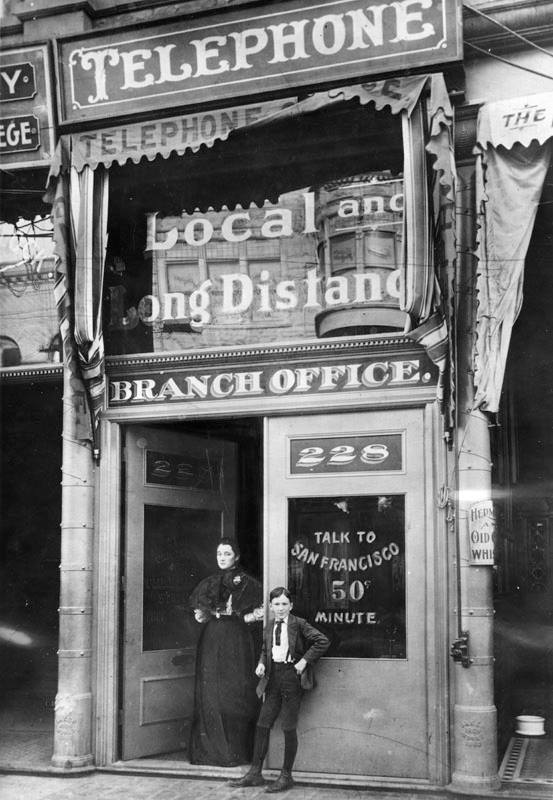
228 South Spring Street is an iconic building located in downtown Los Angeles, which housed the first telephone pay station established in the city of Los Angeles. The building was constructed in the late 19th century and was originally home to the Pacific Telephone and Telegraph Company.
The telephone pay station, which was located inside the building, allowed people to make telephone calls and pay for them using coins. The station was an important innovation for the city, as it provided a way for people to communicate quickly and easily, without having to travel to a central location.
The photograph of 228 South Spring Street taken in 1899 captures the early days of the telephone industry in Los Angeles, when telephones were still a relatively new technology. In the image, we can see the building’s ornate façade and large windows, which were designed to let in natural light and create an open, inviting atmosphere.
Today, 228 South Spring Street is a historic landmark and is home to a variety of businesses and organizations. The building’s rich history and architectural beauty make it a popular destination for tourists and locals alike, and it continues to be an important part of the city’s cultural and economic landscape.
6. Casaba Field near the corner of Sunset and Harper in West Hollywood c. 1918
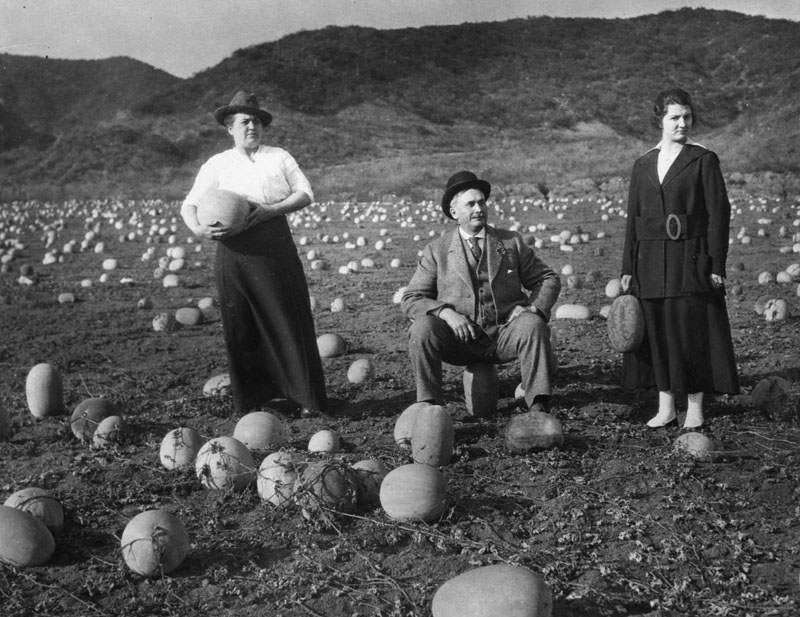
The Casaba Field was a historic landmark located near the corner of Sunset and Harper in West Hollywood. The field was used for various purposes, including aviation, agriculture, and entertainment, during its time in operation.
In the early 1900s, the Casaba Field was used as a training ground for aviation pioneers, including Glenn Curtiss and Calbraith Perry Rodgers, who made the first transcontinental flight across the United States. The field was also used for crop cultivation, with farmers growing a variety of crops, including lettuce, tomatoes, and cucumbers.
In the 1910s and 1920s, the Casaba Field became a popular entertainment venue, hosting events such as polo matches, horse races, and air shows. The field was also home to the Casaba Club, a social club that hosted dances, parties, and other events.
The photograph of the Casaba Field taken in 1918 captures the bustling activity and energy of the field during this time. In the image, we can see a group of people gathered together, possibly for a polo match or other event. The field itself is visible in the background, with rows of crops visible in the distance.
Today, the Casaba Field is no longer in operation, but its legacy lives on as a testament to the history and culture of West Hollywood and the surrounding areas. The field remains an important part of the city’s history, and its legacy is celebrated through various events and cultural activities.
7. A Southern California New Year. Oh Happy Day c.1933
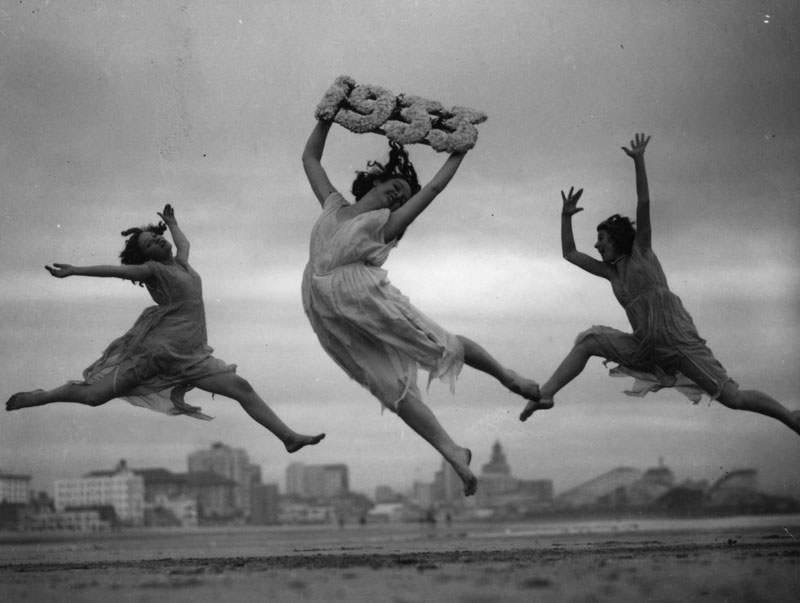
“A Southern California New Year. Oh Happy Day” is a photograph that captures the festive spirit of Los Angeles during the New Year’s celebrations of 1933. The image shows a group of revelers gathered together in front of a large banner that reads “Oh Happy Day” as they ring in the new year.
The scene is filled with joy and excitement, as the revelers dance and sing in the streets, enjoying the warm Southern California weather and the festive atmosphere of the holiday season. The photograph captures the spirit of optimism and hope that was prevalent in Los Angeles during this time, as the city began to emerge from the economic struggles of the Great Depression.
During the 1930s, Los Angeles experienced a period of growth and transformation, as the city expanded its infrastructure and developed new industries, including entertainment, aerospace, and technology. The city also saw the construction of many iconic landmarks, such as the Griffith Observatory and the Los Angeles City Hall, which helped to establish Los Angeles as a major center of culture and innovation.
The photograph “A Southern California New Year. Oh Happy Day” is a testament to the resilience and spirit of the people of Los Angeles, who were able to find joy and happiness in the midst of difficult times. It serves as a reminder of the importance of community, celebration, and optimism in times of struggle and hardship.
8. Griffith Observatory under construction c.1933
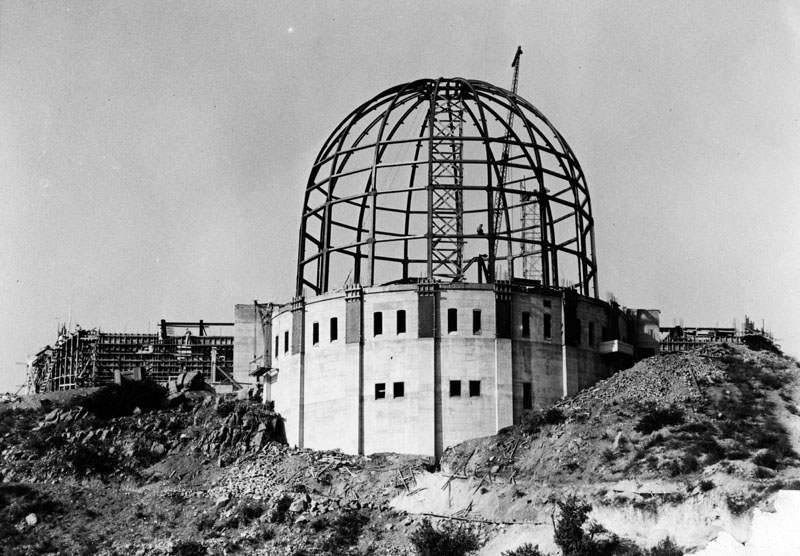
The Griffith Observatory is an iconic landmark in Los Angeles, located atop Mount Hollywood in Griffith Park. The observatory was built in the 1930s and opened to the public in May 1935. The construction of the Griffith Observatory was a major undertaking and involved a team of skilled engineers, architects, and builders.
The image of the Griffith Observatory under construction in 1933 provides a glimpse into the massive scale and complexity of the project. The observatory was designed to be a state-of-the-art facility for astronomy and public education, featuring advanced telescopes, exhibits, and displays that would allow visitors to explore the mysteries of the universe.
The construction of the observatory was funded by a donation from Griffith J. Griffith, a wealthy businessman and philanthropist who believed that access to knowledge and education was a fundamental right for all people. Griffith’s generous donation allowed for the construction of the observatory and the development of its many exhibits and displays, which were designed to inspire and educate visitors of all ages.
9. The General Petroleum Building. One of the first modular system buildings in Downtown c.1948
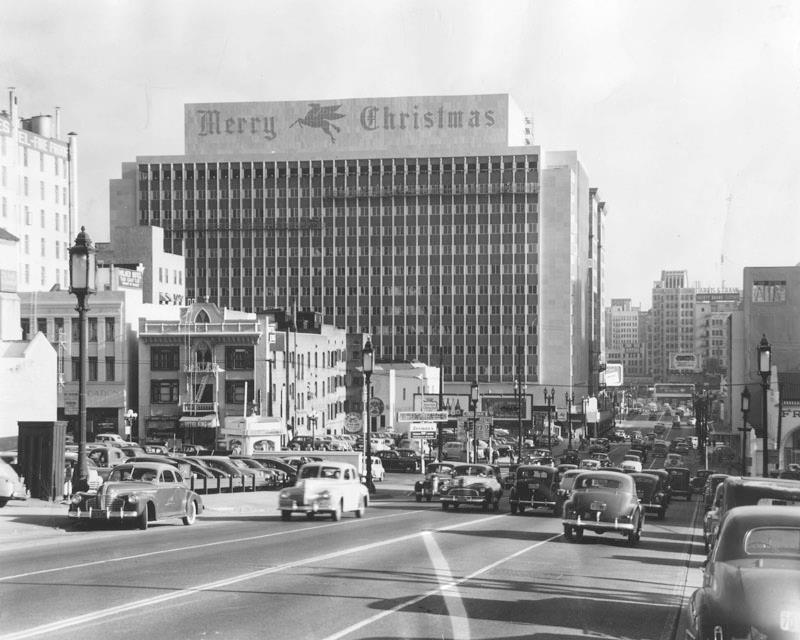
The General Petroleum Building is an iconic skyscraper in Downtown Los Angeles, which was one of the first modular system buildings in the area when it was constructed in 1948. Here are some additional details about the building and its significance:
Modular System: The General Petroleum Building was designed by the architectural firm of Walter Wurdeman and Welton Becket, who were known for their innovative use of modular construction techniques. The building’s structural system was based on a grid of pre-fabricated concrete panels that were assembled on site, allowing for a faster and more efficient construction process.
Art Deco Style: The General Petroleum Building is also notable for its Art Deco style, which was a popular architectural style in the 1920s and 1930s. The building’s sleek lines, geometric shapes, and decorative details reflect the influence of this style, which was known for its emphasis on modernity and luxury.
Height and Location: At 12 stories tall, the General Petroleum Building was one of the tallest buildings in Downtown Los Angeles when it was built. It was also located in a prominent location on the corner of 6th and Flower Streets, which made it a highly visible and prestigious landmark.
Occupants and Use: The building was originally constructed to serve as the headquarters for the General Petroleum Corporation, which was one of the largest oil companies in California at the time. In later years, the building was used by a variety of tenants, including law firms, advertising agencies, and financial institutions.
The General Petroleum Building was an important and innovative addition to the Downtown Los Angeles skyline when it was built in 1948. Its modular construction techniques and Art Deco style were reflective of the architectural trends of the time, and its prominent location and use as a corporate headquarters made it a symbol of the city’s growth and prosperity.
10. Los Angeles High School Football Team. A first for the school c.1900
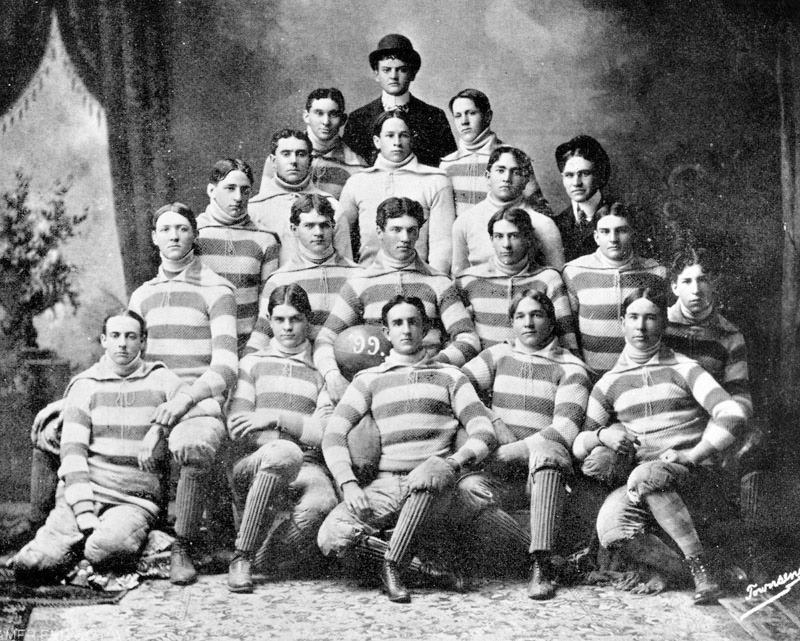
Los Angeles High School has a rich history of athletics, including its football program, which dates back to the early 1900s. Here are some details about the school’s football team and its accomplishments around that time:
Early History: The Los Angeles High School football team played its first game in 1899, just a year after the school was established. The team was made up of students from the school and was coached by faculty members.
First Championship: The football team quickly became a source of pride for the school and the community, and in 1900, it won its first championship by defeating a team from Pasadena High School. This was a significant achievement for the school, as it was the first time that the football team had won a championship.
Growing Success: Over the next decade, the Los Angeles High School football team continued to grow in popularity and success. It won several more championships, and its games drew large crowds of spectators.
Notable Players: The football team also produced several notable players during this time, including Louis Van Doren, who went on to play for the University of California, Berkeley, and later served as the mayor of Los Angeles.
Legacy: The success of the Los Angeles High School football team helped to establish the school’s reputation as a center of athletic excellence. It also helped to popularize football in the city and contributed to the growth of high school sports programs throughout the region.
The Los Angeles High School football team was a pioneering force in the early days of high school athletics in Los Angeles. Its success and legacy continue to be celebrated by the school and the community to this day.
11. The Uplifters Club (an offshoot of the Los Angeles Athletic Club) after a long day of socializing in the hills near Santa Monica. They were known as a high-class drinking club c.1938
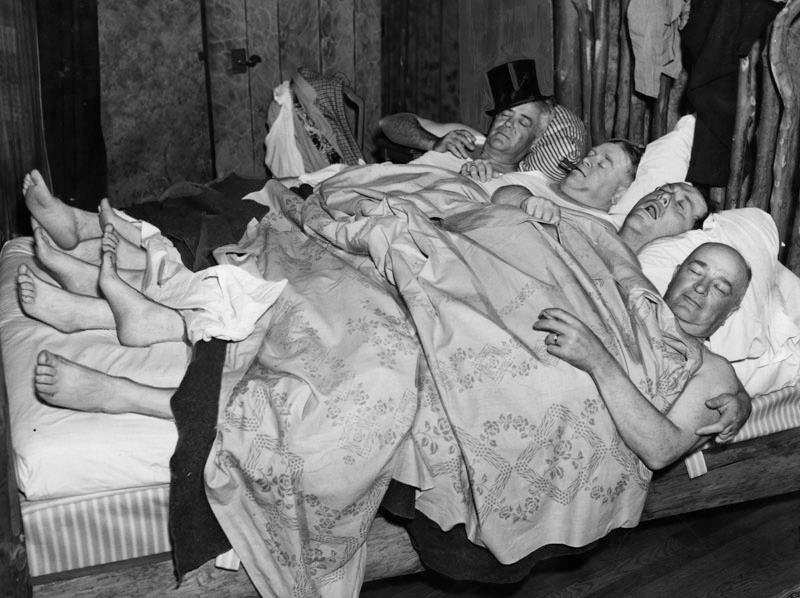
The Uplifters Club was a social club that was formed in the early 20th century by a group of prominent Los Angeles businessmen and athletes. The club was known for its exclusive membership, high-class social events, and reputation as a drinking club. Here are some additional details about the club and its activities in the late 1930s:
Membership: The Uplifters Club was initially an offshoot of the Los Angeles Athletic Club and was made up of some of the most influential and wealthy men in the city. Membership was by invitation only, and prospective members had to be nominated by existing members and go through a rigorous vetting process.
Social Events: The club was known for its extravagant social events, which were held in the hills near Santa Monica and other exclusive locations around Los Angeles. These events included barbecues, picnics, and parties, and were attended by both members and their families.
Reputation: The Uplifters Club had a reputation as a drinking club, and alcohol was a prominent feature of many of its events. Members were known to enjoy high-end cocktails, wine, and champagne, and the club’s bar was well-stocked with top-shelf liquor.
Legacy: The Uplifters Club played an important role in the social and cultural life of Los Angeles in the early 20th century. It was a place for the city’s elite to socialize and network, and its members were involved in a wide range of philanthropic and civic activities. While the club eventually disbanded in the mid-20th century, its legacy continues to be felt in the city today.
The Uplifters Club was a high-profile and influential social club in Los Angeles during the late 1930s. While its reputation as a drinking club may have been controversial at the time, its members played an important role in shaping the city’s culture and society.
12. Dudes with shovels c.1900
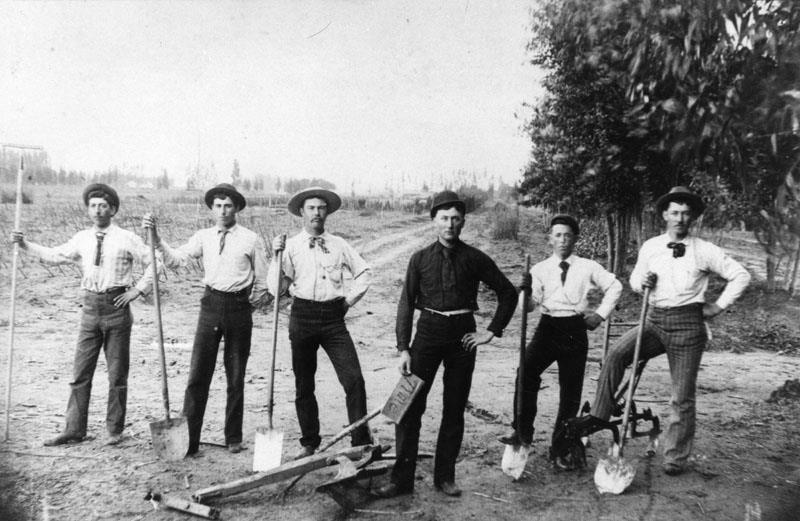
The image of “dudes with shovels” from around 1900 is likely a reference to the early days of the city’s growth and development. During this time, Los Angeles was a rapidly expanding city, and many new buildings and infrastructure projects were underway.
One of the most notable projects from this period was the construction of the Los Angeles Aqueduct, which brought water from the Owens Valley to the city and helped to fuel its growth. The aqueduct was a massive undertaking, involving the excavation of tunnels, the construction of dams and reservoirs, and the laying of pipes across hundreds of miles of rugged terrain.
To carry out this work, thousands of laborers were needed, many of whom were unskilled and often referred to as “dudes with shovels.” These workers were responsible for digging trenches, removing debris, and performing other manual labor tasks.
While the work was often grueling and dangerous, it also provided employment opportunities for many people and helped to fuel the city’s growth and development. The construction of the aqueduct, along with other infrastructure projects of the time, helped to transform Los Angeles from a small western town into a major metropolitan center.
13. Wilshire at Virgil c.1930
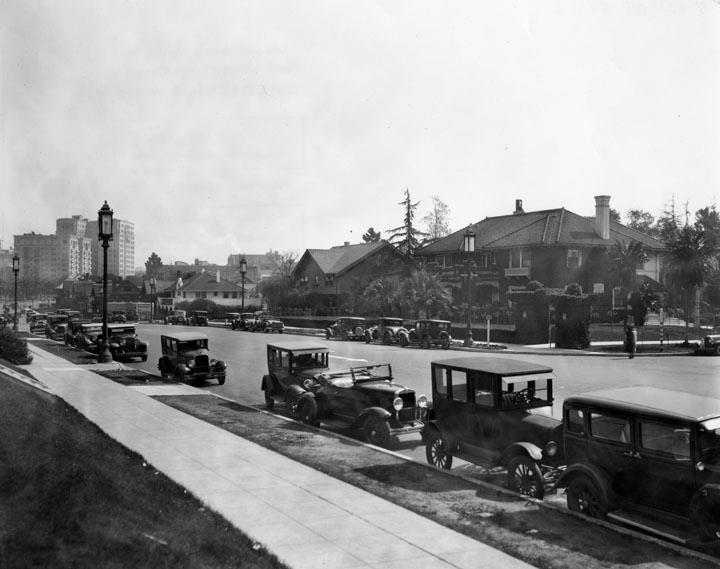
Wilshire Boulevard and Virgil Avenue in 1930 was a bustling intersection in the Mid-Wilshire district of Los Angeles. At this time, Wilshire Boulevard was still in the process of being developed into a major commercial and cultural hub, and many of the iconic buildings and landmarks that would come to define the area had yet to be built.
Some notable features of the intersection at Wilshire and Virgil in 1930 might have included:
Streetcars: In the early 20th century, Los Angeles had an extensive streetcar system, and the intersection of Wilshire and Virgil would have been a major hub for transit. Streetcars would have carried passengers to and from downtown Los Angeles, as well as to other neighborhoods throughout the city.
Commercial buildings: While many of the iconic buildings on Wilshire Boulevard had yet to be constructed in 1930, there were likely a number of commercial buildings at the intersection of Wilshire and Virgil. These might have included shops, restaurants, and other businesses that served the needs of the growing population in the area.
Automobile traffic: While Los Angeles was still a relatively young city in 1930, automobile traffic was already becoming a major feature of its streets. The intersection at Wilshire and Virgil would have seen a mix of pedestrian, streetcar, and automobile traffic, as well as the occasional horse-drawn carriage.
Changing demographics: The early 20th century was a period of significant demographic change in Los Angeles, as the city’s population swelled and new communities took shape. At the intersection of Wilshire and Virgil, there were likely people from a wide range of backgrounds and walks of life, reflecting the diversity of the city as a whole.
14. The Los Angeles Police Pistol Range in Elysian Park. These women are practicing for the turkey shoot, incredibly sponsored by the police department _c.1934
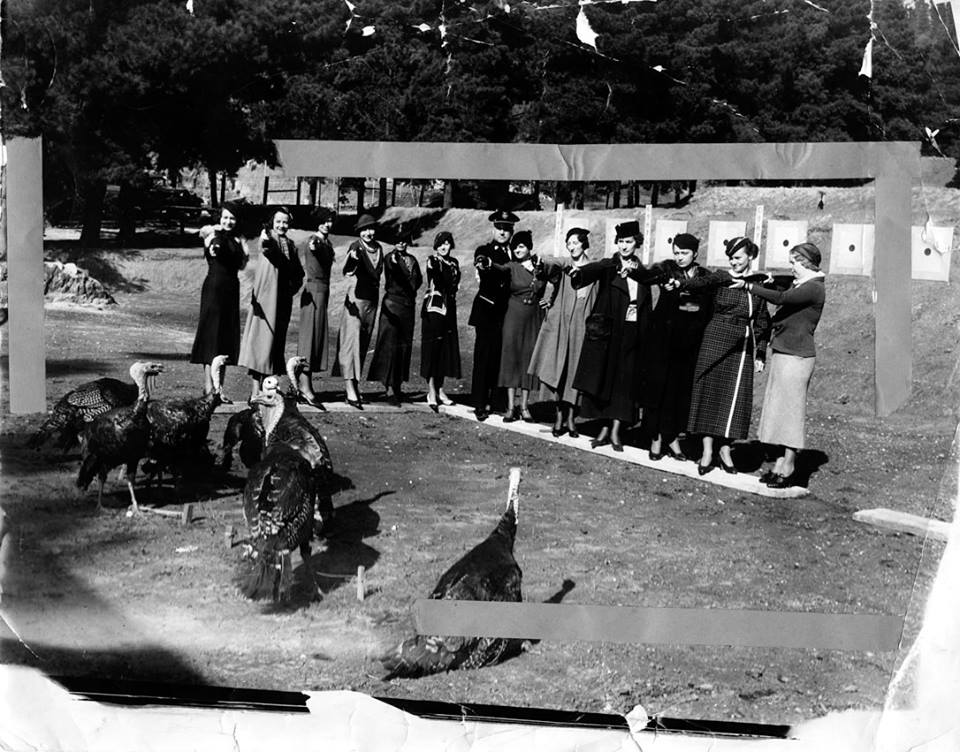
The Los Angeles Police Pistol Range in Elysian Park, located just north of downtown Los Angeles, was a popular shooting range for law enforcement officers and civilians alike in the early 20th century. The range was established in 1925 and quickly became a hub for firearms training and competition in the region.
The image of women practicing for the turkey shoot sponsored by the police department in 1934 highlights the growing interest in shooting sports among women during this period. The turkey shoot was a popular competition in which participants would aim to hit a target in the shape of a turkey, with the winner taking home a frozen turkey as a prize.
While shooting sports were traditionally seen as a male-dominated activity, the image of women participating in the turkey shoot at the Los Angeles Police Pistol Range in Elysian Park underscores the growing interest in firearms and marksmanship among women in the early 20th century. This interest was likely fueled in part by the rise of women’s suffrage and the growing sense of empowerment and independence among women during this period.
The Los Angeles Police Pistol Range continued to be a popular destination for shooters throughout the 20th century, and it remains in operation to this day, offering training and competition opportunities for law enforcement officers and civilians alike.
15. Sackett Hotel and Emporium at the corner of Cahuenga and Hollywood Blvd. The first hotel built in Hollywood c.1899
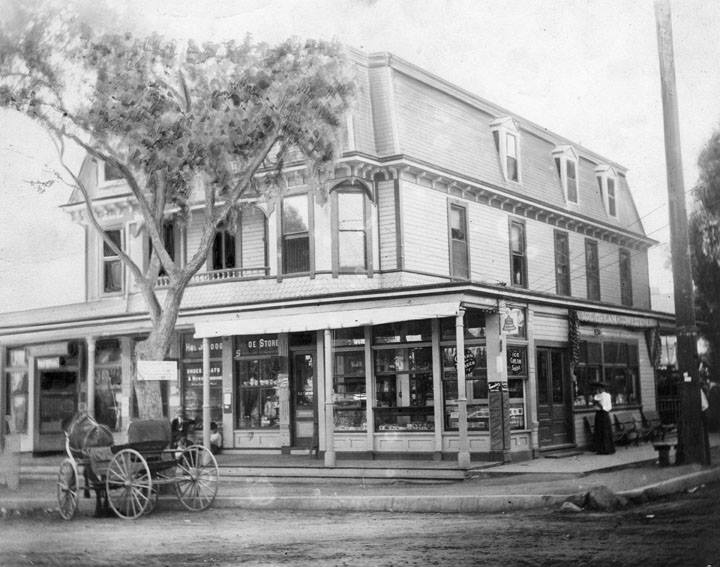
The Sackett Hotel and Emporium, located at the corner of Cahuenga and Hollywood Boulevard, was the first hotel to be built in Hollywood, California. It was established in 1899 by a businessman named Albert Sackett, who saw the potential for growth and development in the area and decided to invest in a hotel to serve the growing population of visitors and residents.
At the time of its construction, the Sackett Hotel and Emporium was a landmark building in Hollywood, with four stories and 60 rooms. The hotel was considered luxurious for its time, with amenities like electric lights and indoor plumbing, which were still relatively new innovations in the late 19th century.
In addition to its accommodations, the Sackett Hotel and Emporium also featured a variety of retail shops and other businesses on its ground floor. The hotel was designed to be a one-stop destination for visitors to Hollywood, offering a range of services and amenities in one convenient location.
Over the years, the Sackett Hotel and Emporium played an important role in the development of Hollywood as a major center of entertainment and culture. The hotel hosted a number of important events and guests, including the first Academy Awards ceremony in 1929, which was held in the Blossom Room of the nearby Hollywood Roosevelt Hotel.
While the Sackett Hotel and Emporium was eventually demolished in the 1950s to make way for new development, its legacy lives on as a symbol of the early days of Hollywood and the growth and transformation of the area from a small town into a major cultural and entertainment hub.
Rare Vintage Footage Of Old Los Angeles Landmarks
A Drive Through Downtown Los Angeles (1940s)
Historically home to the Chumash and Tongva, Los Angeles was claimed by Juan Rodríguez Cabrillo for Spain in 1542 along with the rest of what would become Alta California. The city was officially founded on September 4, 1781, by Spanish governor Felipe de Neve. It became a part of Mexico in 1821 following the Mexican War of Independence.
Here are some historical facts about Los Angeles between 1900 and 1930:
Hollywood’s Rise: The movie industry began to take hold in Hollywood in the early 1900s, with the establishment of the first film studio, the Nestor Company, in 1911. By the 1920s, Hollywood had become the center of the movie industry, and the glamour and glitz of Hollywood celebrities began to shape the city’s identity.
The First Automobiles: The automobile industry also began to take off in Los Angeles during this time. The first automobile dealership in the city opened in 1904, and by 1929, there were over 500,000 cars registered in Los Angeles County.
Water Supply: In 1913, the Los Angeles Aqueduct was completed, bringing water from the Owens Valley to Los Angeles. This allowed the city to grow rapidly and helped turn it into the major metropolis it is today.
Oil Boom: In the 1920s, Los Angeles experienced an oil boom, with the discovery of the Los Angeles City Oil Field. This led to a rapid increase in the city’s population and wealth.
Prohibition: Prohibition went into effect in 1920, making the production and sale of alcohol illegal. However, Los Angeles became known as a hotbed of speakeasies and illegal drinking establishments, and organized crime began to flourish in the city.
Infrastructure Development: During the 1920s, Los Angeles invested heavily in infrastructure development, building new roads, bridges, and buildings. Some of the most notable projects included the construction of the Los Angeles City Hall, the Griffith Observatory, and the Hoover Dam, which provided electricity to the city.
Racial Tensions: The 1920s were a time of heightened racial tensions in Los Angeles, with a rise in anti-immigrant sentiment and discrimination against minority groups. The Ku Klux Klan was active in the city during this time, and there were several incidents of racial violence, including the 1927 Chinese Massacre, in which 10 Chinese Americans were murdered.
See Also:
15 Rare & Old Photos of Las Vegas | Mega Series- Part 5
20 Rare & Old Photos of San Francisco | Mega Series Part 2
15 Rare & Old Photos of New York | Mega Series Part 1
If you like this post, Then please, share it in different social media. Help our site to spread out.
